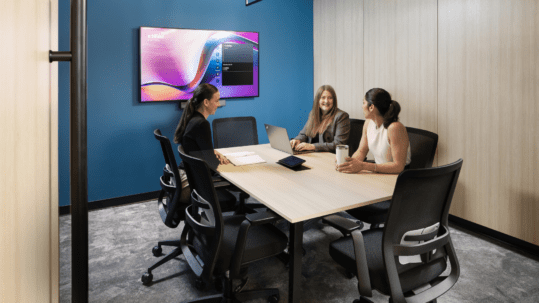The very first iterations of a so-called modern office were rolled out to the masses in the early 1900’s. Most of them featured an open concept layout to support collaboration and communication – but they also contributed to massive levels of noise and distraction. Cue the 1950’s cubicle revolution, which went a little too far in the other direction and inspired unintentional isolation and a drop of office worker morale.
The most up-to-date commercial interior design mantra does something in the middle, option to include aspects of both to accommodate the individual working styles of different employees who need different environments to accomplish different tasks – but the biggest breakthrough of 2018 has proven to be the inclusion of more and more advanced commercial interior design technologies.
Here are our top 5 breakthroughs in commercial interior design technologies.
Virtual Reality Communications
Remember the hologram meetings the Empire or Rebel Alliance would host in Star Wars, with the fuzzy life-size visual of Darth? While virtual reality conferencing may not quite be on that level just yet, virtual reality communications are soon to be the mainstream choice of tech-savvy firms the world over.
With current teleconferencing, individuals can carry on with their everyday tasks, or ignoring the meeting altogether because they’re not visible to the other attendees; alternatively, video conferencing has similar issues with participant engagement – a meeting attendee can still do their own thing on-screen in privacy, rendering the meeting ineffective. Virtual reality conferencing allows users in different locations to literally meet in a room together to present CAD 3D models of new products, or share plans.
Skype and Zoom are proving to hold onto their relevancy, as these technologies have become a staple of modern office experiences, and help take meetings to new levels with reliable and high-quality face-to-face video conferencing.
Visual & Collaborative Brainstorming
Video conferencing and screen sharing are nothing new – but more and more offices are embracing these tech advances as the primary go-to technology for boosting efficiency in the office and communicating creative ideas in real time.
Screen sharing technologies give meeting attendees a front row view of the presenters screen from anywhere in the world, helping them gain unprecedented access to Powerpoint presentations, product designs, or brainstorming ideas for discussion.
Think back to an old school in-office presentation. Much like an elementary classroom, the presenter would use a black/whiteboard to illustrate and take notes of the topic at hand – but in 2018, these visual supports have received a much-needed makeover.
Google recently introduced a revolutionary G-Suite tool called Jamboard, a virtual whiteboard conferencing app, enabling individual employees from multiple different departments or offices to collaborate and view a singular screen for multiple meeting attendees to draw on and contribute to during brainstorming sessions.
Video Communication
Inbound giant, Hubspot, tells us that over 50% of marketers agree video is still the king of creative content, and it provides the best ROI for organizations, prompting some tech groups to embrace video as a means of email communication as well.
Similar to rapport building video conferencing technologies of 2018, video communications are also changing the ways people interact and exchange ideas and correspondence when they’re not live or in a meeting. Programs like Vidyard allow office employees to record and create simple, short video messages as emails, eliminating text, and adding a personal touch that text messages and voice messages can’t come close to.
Videos also help to better communicate context, voice, and tone, helping to more authentically engage workplace communication needs and eliminate any unwanted misinterpretation.
Gamification Culture
Gamification is a growing and expansive methodology used predominantly in education and training circles, but more and more commercial office environments are using games as a way to build company culture. Hosting a trivia, or video joke session via Slack, for example, which can be used to boost company morale as a way of introducing and familiarizing staff with each other.
From a team building perspective, gamification is easy to accommodate, fun, and a great way to connect individuals who may not get the chance to interact at work otherwise.
Advancing the fun-having identity of gamification and connective apps like Slack, Google Drive, and Google Hangouts, organizations are voluntarily employing the concept of “remote week” wherein they encourage employees to work from their favourite location — a coffee shop, the cottage, home, etc — as a way to encourage them to better understand these fun and engaging modes of communication and collaboration, but also as a way to introduce and familiarize themselves with telecommuting and the many benefits of a liberated and mobile workforce.
Voice Recognition & Activation
Studies show nearly half of all American routinely use digital voice assistants like Apple’s infamous Siri, Amazon Echo, and Google Home – so it’s no surprise that more and more office employees and organizations are using these computing voice assistants to accelerate tasks and minimize the impact of small tasks.
Voice assistants are excellent for scheduling meetings, sending messages, setting timeline-based goals and reminders, and typing notes; so they’re literally like an extra set of hands, and a quick and painless way to make staying on top of your day-to-day office life a breeze.
—
Easy accessibility, remote capabilities, advanced communication tools, and the rapid rise of the telecommuter demographic have prompted technology to make rapid changes to keep up with the ever-evolving office. Similarly, offices are also using consumer technologies in more professional capacities to bridge the gap between work and personal life – and that to us means people are happier; using commercial interior design office tech is making office life easier and enjoyable.






